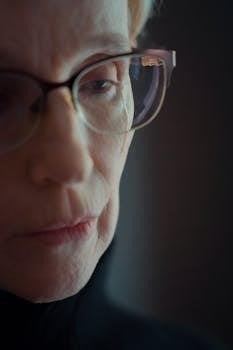Georges Bataille’s “Story of the Eye”, published in 1928, delves into the realm of erotic fiction. The narrative follows the narrator’s relationship with Simone, exploring their transgressive sexual escapades. The novel’s themes include taboo, transgression, and the grotesque, making it a controversial work.
Overview of Georges Bataille’s “Story of the Eye”
Georges Bataille’s “Story of the Eye” is a novella exploring themes of eroticism, transgression, and the unsettling. Published in 1928, it follows the narrator and his companion, Simone, through a series of increasingly bizarre and sexually charged encounters. The story is notorious for its graphic depictions of sex, death, and bodily fluids, pushing the boundaries of acceptable literature at the time and even today.
The eye itself acts as a central symbol throughout the narrative, representing a focal point for the characters’ desires and anxieties. Bataille uses the eye to explore the nature of perception, voyeurism, and the human fascination with the grotesque. “Story of the Eye” is a challenging and disturbing read, but it remains a significant work of 20th-century literature due to its unflinching exploration of the darker aspects of human sexuality.

Story of the Eye⁚ An Exploration
Publication History and Initial Reception (1928)
“Story of the Eye” by Georges Bataille was initially published in 1928 under the pseudonym Lord Auch. This anonymity was crucial due to the novella’s highly explicit and transgressive content, which would have been considered scandalous at the time. The book circulated primarily within intellectual and artistic circles interested in surrealism and avant-garde literature.
The initial reception was understandably muted publicly, but within its underground readership, it garnered attention for its unflinching exploration of sexuality and its challenging of societal norms. It was seen as a radical departure from traditional literary conventions. The book’s themes of eroticism, death, and decay shocked some while intriguing others, making it a controversial and sought-after work. Its publication marked a significant moment in the development of Bataille’s unique literary voice.
Bataille’s “Story of the Eye” explores themes of eroticism, transgression, and the grotesque. The narrative delves into taboo subjects, challenging societal norms. The story intertwines sexuality, death, and decay, creating a disturbing and thought-provoking exploration of the human condition.
Eroticism and the Grotesque in Bataille’s Work
Georges Bataille’s “Story of the Eye” is notorious for its explicit exploration of eroticism intertwined with the grotesque. The novel presents a world where sexuality is not merely a source of pleasure but is often linked to disturbing imagery, bodily fluids, and taboo acts. This fusion creates a sense of unease and challenges conventional notions of beauty and desire. Bataille uses the grotesque to disrupt the reader’s expectations, forcing them to confront the darker, more primal aspects of human nature. The characters engage in acts that push the boundaries of social acceptability, blurring the lines between the sacred and the profane. This deliberate transgression serves to question societal norms and explore the hidden desires that lie beneath the surface of civilized behavior. The grotesque elements, such as the recurring motifs of eyes, eggs, and bodily fluids, become symbolic representations of the characters’ internal states and their exploration of forbidden territories.
The Symbolism of the Eye
In Georges Bataille’s “Story of the Eye,” the eye transcends its literal function as an organ of sight and becomes a potent symbol laden with multiple layers of meaning. It represents voyeurism, sexual obsession, and the transgression of boundaries. The eye is often associated with acts of looking and being looked at, highlighting the power dynamics inherent in the characters’ interactions. Moreover, the eye’s round shape and fluid content connect it to other recurring motifs in the novel, such as eggs and testicles, further emphasizing themes of sexuality and fertility, but also of vulnerability. The removal or mutilation of eyes within the narrative suggests themes of castration, sacrifice, and the disruption of established orders. Bataille uses the image of the eye to explore the limits of human perception and the unsettling nature of desire. It serves as a constant reminder of the characters’ fixation on the forbidden and their willingness to push beyond the boundaries of social and moral norms. The eye, therefore, becomes a central element in Bataille’s exploration of the human psyche and its capacity for both ecstasy and horror.

Themes and Motifs
Exploration of Taboo and Transgression
“Story of the Eye” is notorious for its relentless exploration of taboo and transgression. Bataille deliberately challenges societal norms and moral boundaries through graphic depictions of sexual acts, violence, and scatological imagery. The characters engage in behaviors that are widely considered perverse and unacceptable, pushing the limits of what is considered decent or appropriate. This deliberate violation of taboos serves to expose the underlying anxieties and hypocrisies within society. Bataille explores the allure and danger of the forbidden, suggesting that transgression can be both destructive and liberating. The novel’s explicit content forces readers to confront their own discomfort and prejudices, questioning the very nature of morality and the arbitrary nature of social conventions. By delving into the darkest aspects of human desire, Bataille seeks to provoke and unsettle, ultimately challenging readers to reconsider their understanding of sexuality, power, and the boundaries of human experience. The narrative thrives on pushing against established norms, creating a space where the unspeakable and the unthinkable are brought to the forefront.
Björk, the Icelandic artist, has cited “Story of the Eye” as a major inspiration. Her music video alludes to Bataille’s erotic use of eggs. This highlights the novel’s lasting impact on contemporary art and its themes.
Influence on Björk’s Work
Björk Guðmundsdóttir, the acclaimed Icelandic singer-songwriter, has openly acknowledged “Story of the Eye” as a significant influence on her artistic vision. This influence is evident in her visual work, particularly in a music video that subtly references Bataille’s provocative and symbolic use of eggs. Björk’s interest in the novel underscores its enduring relevance and its capacity to inspire artists across different mediums.
The connection between Björk’s art and Bataille’s work highlights the novel’s exploration of sexuality, transgression, and the grotesque, themes that resonate with Björk’s own willingness to push boundaries and challenge conventional norms; Her engagement with “Story of the Eye” demonstrates the novel’s power to provoke thought and inspire creative expression in contemporary art.

Literary and Artistic Influences
Connections to Surrealism
“Story of the Eye” exhibits strong connections to the Surrealist movement, sharing its interest in exploring the subconscious, challenging societal norms, and embracing the irrational. Bataille’s work, like Surrealist art, often delves into themes of eroticism, the grotesque, and the unsettling aspects of human experience. The novel’s unconventional narrative structure and dreamlike imagery align with Surrealist aesthetics.
Furthermore, the novel’s exploration of taboo subjects and its rejection of traditional morality resonate with the Surrealist movement’s desire to disrupt conventional thought and behavior. While Bataille’s relationship with Surrealism was complex, “Story of the Eye” reflects a shared interest in challenging the boundaries of art and exploring the depths of human desire and perversion, marking it as a significant contribution to the movement’s legacy.
Finding a PDF of “Story of the Eye” online is relatively easy. Many websites offer free downloads of the ebook. Readers can access the text on various devices, increasing its accessibility and circulation.
Finding the PDF Online
Locating a PDF version of Georges Bataille’s “Story of the Eye” is generally straightforward due to its public domain status and widespread digital availability. A simple online search for “Story of the Eye PDF” will yield numerous results, leading to websites offering free downloads of the ebook. However, it’s crucial to exercise caution and ensure the website is reputable to avoid potential malware or copyright infringement issues.
Several online platforms, including digital libraries and ebook repositories, host PDF versions of the novel. These sources provide readers with convenient access to the text, allowing them to engage with Bataille’s work on various devices such as computers, tablets, and smartphones. This digital accessibility has undoubtedly contributed to the book’s continued readership and influence.
Availability and Accessibility
Online Reading Communities and Discussions
The internet has fostered vibrant online communities where readers can engage in discussions about “Story of the Eye.” These platforms offer a space for individuals to share their interpretations, analyses, and reactions to Bataille’s provocative work. Online forums, book clubs, and social media groups often dedicate threads or entire discussions to exploring the novel’s themes, symbolism, and literary merit.
Participating in these communities can enrich one’s understanding of the text by exposing them to diverse perspectives and critical insights. Readers can exchange ideas, debate interpretations, and delve deeper into the complexities of Bataille’s writing. These online spaces also serve as a valuable resource for discovering related works, critical essays, and biographical information about the author, fostering a more comprehensive appreciation of “Story of the Eye” and its place in literary history.
Critical Reception and Interpretation
“Story of the Eye” holds an underground classic status, rediscovered by each new generation. Its transgressive content and exploration of taboo themes have ensured its enduring appeal, despite initial controversy, cementing its place in literary history.
Underground Classic Status
“Story of the Eye” has achieved an underground classic status, suggesting its enduring appeal despite its controversial nature. The novel’s exploration of taboo subjects like eroticism and transgression continues to resonate with readers who seek unconventional literature. Its initial reception was polarizing, yet it has gradually garnered recognition for its literary merit and influence on subsequent artists and writers.
The book’s themes of sexuality, death, and the grotesque contribute to its cult following. Each generation rediscovers “Story of the Eye”, drawn to its provocative content and philosophical undertones. Its accessibility through online platforms, including PDF versions, has further amplified its reach and impact.
Interpretations and Analyses of the Text
“Story of the Eye” has been subject to diverse interpretations and analyses, reflecting its complex themes and symbolism. Some critics view the novel as an exploration of the human psyche, particularly the darker aspects of desire and obsession. The symbolism of the eye is often interpreted as representing vision, voyeurism, and the piercing gaze of the unconscious.
Others analyze the text through a philosophical lens, examining its engagement with existentialism, nihilism, and the limits of human experience. The grotesque elements in the story are seen as challenging conventional notions of beauty and morality. The novel’s transgressive nature invites readers to confront uncomfortable truths about themselves and society.
Georges Bataille authored numerous other works exploring similar themes of eroticism, transgression, and the grotesque. These include “Madame Edwarda,” “Blue of Noon,” and “The Tears of Eros,” delving into the complexities of human desire and existential limits.
Other Works by Georges Bataille
Georges Bataille’s literary output extends far beyond “Story of the Eye,” encompassing a wide range of novels, essays, and philosophical treatises. He consistently explored themes of eroticism, death, and the sacred in his writing. “Madame Edwarda” presents a graphic and disturbing portrayal of sexuality and existential crisis. “The Tears of Eros” delves into the history of art and its connection to eroticism and death.
“Blue of Noon” weaves a complex narrative of desire, war, and political intrigue. Bataille’s works often challenge conventional morality and societal norms, pushing the boundaries of literature. His unique blend of philosophy and fiction continues to provoke and inspire readers, solidifying his place as a significant figure in 20th-century literature.

Related Works and Adaptations
Potential Adaptations and Allusions in Other Media
The provocative nature of Georges Bataille’s “Story of the Eye” has made it a source of inspiration and allusion in various forms of media. Björk’s music video, drawing on Bataille’s imagery, showcases the potential for visual interpretations. The novel’s themes of transgression and eroticism could be explored in film, pushing boundaries. However, the graphic content presents challenges for adaptation.
Independent filmmakers seeking to challenge norms may find the source material compelling. Allusions to the novel’s symbolism, particularly the eye, could be subtly woven into other works. Bataille’s influence extends to visual arts, inspiring artists to explore themes of desire and the grotesque. “Story of the Eye” remains a wellspring of challenging ideas.
